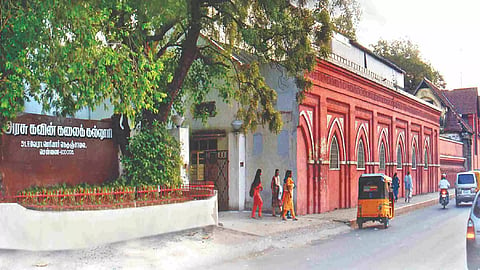

CHENNAI: For over 200 years, Madras has been the educational hub. An outsider could wonder as to how the city has institutions for all specialisations. From cookery to catering, music, Sanskrit, and even sports and war
Madras was one of the earliest cities to think of teaching fine arts in a college. Arts had been established as a profession in Europe but in India, it had to set roots. People became artists of their free will.
The Fine Arts College in Egmore, set up by the British is one of the earliest and foremost colleges of fine arts in this part of the world.
Madras was a city of polymaths with even one of its Collectors translating Tirukkural and writing Sangam-styled poetry, doctors for their share did more than treat the sick and disabled. They started mulberry farms, designed buildings, and started the museum and the zoo. A surgeon, named Hunter, was an artist and one of the earliest photographers. In fact, he founded the Photographic Society of India.
He was also deeply interested in pottery and handicrafts and traveled widely into the south Indian cities and saw first-hand the making of them. He wanted to encourage the handicraft industry.
With the remuneration he made as a surgeon and by the sale of his paintings, he started an art school on Broadway.
He also stressed the government should start more art schools across the Presidency, to educate the locals in arts and crafts.
The school, while functioning on Broadway, was taken over by the government. It was renamed as Institute of Useful Arts while Hunter was retained as its consultant. A four-acre property was acquired on Poonamalle High Road and the school, which is now upgraded as a college, was shifted there.
The London Industrial Exhibition in Hyde Park was one of the memorable and successful public events of the century. It was highly influential in determining the course of industry thereafter. The audience thronged in huge numbers at Hyde Park to see the industrial skills of the countries across the globe. Dr. Hunter ensured many products of his school were displayed and sold in the exhibition. In fact, the response that the sale garnered, changed the outlook of the school to more commercially viable art. The products from Madras decorated the living rooms of royal palaces in Europe from then.
The college started producing artifacts for the nobility of England. Wooden artifacts, metalwork, and handicrafts were its mainstay production.
With around 180 students, the institution was then renamed to Madras School of Art and Industry.
The college still houses a great collection of photographs of Madras, Mahabalipuram, Chidambaram, Nilgiris, Kanchi, and Madurai from the late 1800s.
Havel who took over the college as principal ushered in a golden era. He was impressed with the gurukulam education system and tried to replicate it in the school. He brought in potters, metalsmiths, and carpenters to teach the students. Students traveled to Elephanta, Ajanta, and Ellora heritage sites; they would cycle to Mahabalipuram for day trips to sketch the pagodas. The Indo-Saracenic architect Chisholm, who was also deeply interested in art, would later head the college as principal holding charge as the chief architect of the presidency simultaneously.
Chisholm introduced several aspects of handicraft teaching. He also introduced aluminum work to the students. This, though innovative, unfortunately, changed the college as a utensil manufacturing industry for a few years.
It was the onset of Indian principles that stemmed this disturbing tide of events.
Debi Prasad Roy Chowdhury became the Deputy Principal and rose to head the institution. Debi had done the two most recognisable statues of this city- Gandhi and the triumph of labour on the Marina while serving here. For 30 years, he led the college into becoming a premier institution for painters and sculptors of Indian origin. Sooner, it became a national institution. After Chowdary came to Panikkar who initiated the Madras art movement and the artists village in Cholamandal along with the students.
Many students of the college became widely acclaimed artists and sculptors and even in the film industry as art directors.
In a time when art is considered an investment this college marching towards its second centennial is a landmark in putting the native artists on par with the rest of the world. The college has given shape to the desires and aspirations of many artists.